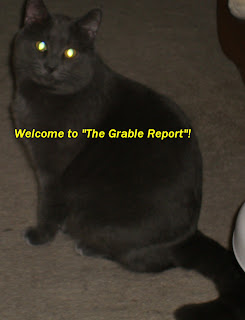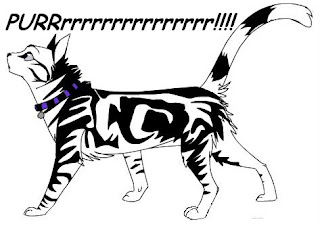Hello and welcome friends to the May 12, 2013 edition of The Grable Report. I am Grable Davey and today I would like to talk about the largest epidemic and leading cause of death in cats around the world. - FELV, better known as Feline Leukemia Virus.
Feline Leukemia is a virus that affects Cats only, and cannot be transmitted to humans or other species of animals such as dogs. This virus causes a breakdown in a cats immune system, which in turn can cause the cat to be susceptible to other diseases that their bodies immune systems would normally fight off.
There are many truths and myths about this disease, and it is important to know the difference between the two when faced with the posibility of having a cat with this diesase...
First, here is the biggest myth of all...Having FELV is an automatic death sentence for your cat. Many people are advised by their Vet that a cat who is FELV is better off being put down. This is simply NOT TRUE!!! The truth is, that many kittens and cats each year are falsely diagnoised with this disease after one blood test. Because the tests used for detection of the virus have a high rate of false positive results, it is important to have your kitty vaccinated for the virus and then re-tested again in 3 months time.
Your Veterinary professional has two tests that can be done to check for FELV. The first test known as ELISA is a test that uses your cats blood, and when mixed with the test chemicals checks for changes in the bloods color. If the tested blood changes color, it is considered a positive reaction to the disease in your cats system. Because of the high rate of false positive results, it is not considered to be really accurate by many professionals. With this test, you can also have a light positive which shows that your cat has active virus in its blood, but it is not very active in your cats body. At this point, there is a very good chance that given the vaccinations, your cat's own immune system can throw off the virus if it is indeed, a true positive reading. Based on research, approx. 40% of all cats who test positive and then are given the vaccines will throw the virus off.
The second test is a much more accurate test known as IFA, and also uses blood from your cat, but this test checks to see if the virus is being produced in your cats bone marrow. If this test is positive, then the likelihood of your cat ever testing negative is very slim.
Regardless of which test you have, please remember that it is always very important to isolate your kitty away from other household cats. Follow up with your Vet in 3 months to have your baby rechecked after the vaccines have been administered! I know this to be true, because when Mommy had me tested when I first went to the Vet, I tested positive for the disease. Dr. Howell advise Mommy & Daddy to get me vaccinated and to be retested in 3 months time.
It seemed like a lifetime to be away from everyone, but, after 3 months, I was again tested and guess what...NO FELV for me!!!!! I was just fine! I have been fine since then and that was over 3 years ago!
Now for more facts and falsehoods for kitties that unfortunately do retest as positive...
If your cat re-tests positive, the most important thing to remember is, that there is no set time span on how long your cat will survive the disease.
Reseachers will give people statistics of 4 years or less (researchers often say 83% of all infected cats will not live past 4 years), but with the increased treatment options that are available in todays medicine, these statistics are no longer neccessarily the case. Many cats are living long full lives while battling the disease.
Myth...there are no viable treatments to slow down the disease...
again not true! Many Vets are now using agressive treatment with drugs such as :
Immuno Regulin
Acemannan
Interferon Alpha
Lymphlocyte T-Cell
Immune Modulator
Staph Protein A
Also, many vitamin and mineral supplements and special diets designed to help blood production have been shown to slow down the progression of the the virus and improve their bodies own immune defenses.
Another helpful thing is, to make sure that your cats dental care is always up to date. Because this virus affects your cats teeth and gums, they can loose teeth and develop gingivitis which can trigger other illnesses if not treated properly. Make sure that you notify your Vet if you notice any changes in your cat's teeth or breath.
Probably the most important care you can give your cat that is FELV positive, is to make sure that its surroundings are as free of stress as possible. Always feed them on a regular schedule. Keep them away from stressful situations like strangers in your home, moving or kenneling, territorial conflicts with other pets, and anything that can cause stress. These things can affect your cats immune system and can trigger illness.
Because of the difficulty of accurately diagnoising FELV, it is important for you as a kitty parent, to be aware of the symptoms of the disease. If you notice any of these signs, make sure to get your baby to the Vet for testing! And most importantly, always stay up to date on your cats vaccines annually.
Symptoms include:
Swollen Lymph Nodes
Toothloss and Gingivitis
Dehydration
Neurological disorders
Sores that do not heal or abscess
Fevers
Diarreha
Vomiting
Unexplained weight loss
For more information on FELV and your treatment options, please visit these 2 great websites. They have FAQ pages to help you better understand the disease, and how to get the help you need, as well as getting your kitty the best treatments possible:
Cornell University Veterinary Medicine
or click here for the Feline Leukemia support organization.
Well thats our report for today. We hope that you have found the information given to be helpful. Please visit us again next time for another edition of the Grable Report. Till then, I am Grable Davey, and remember, all cats are individuals and many have special needs. Always give us the care and love we need, and we will return your love a thousand times over!!













